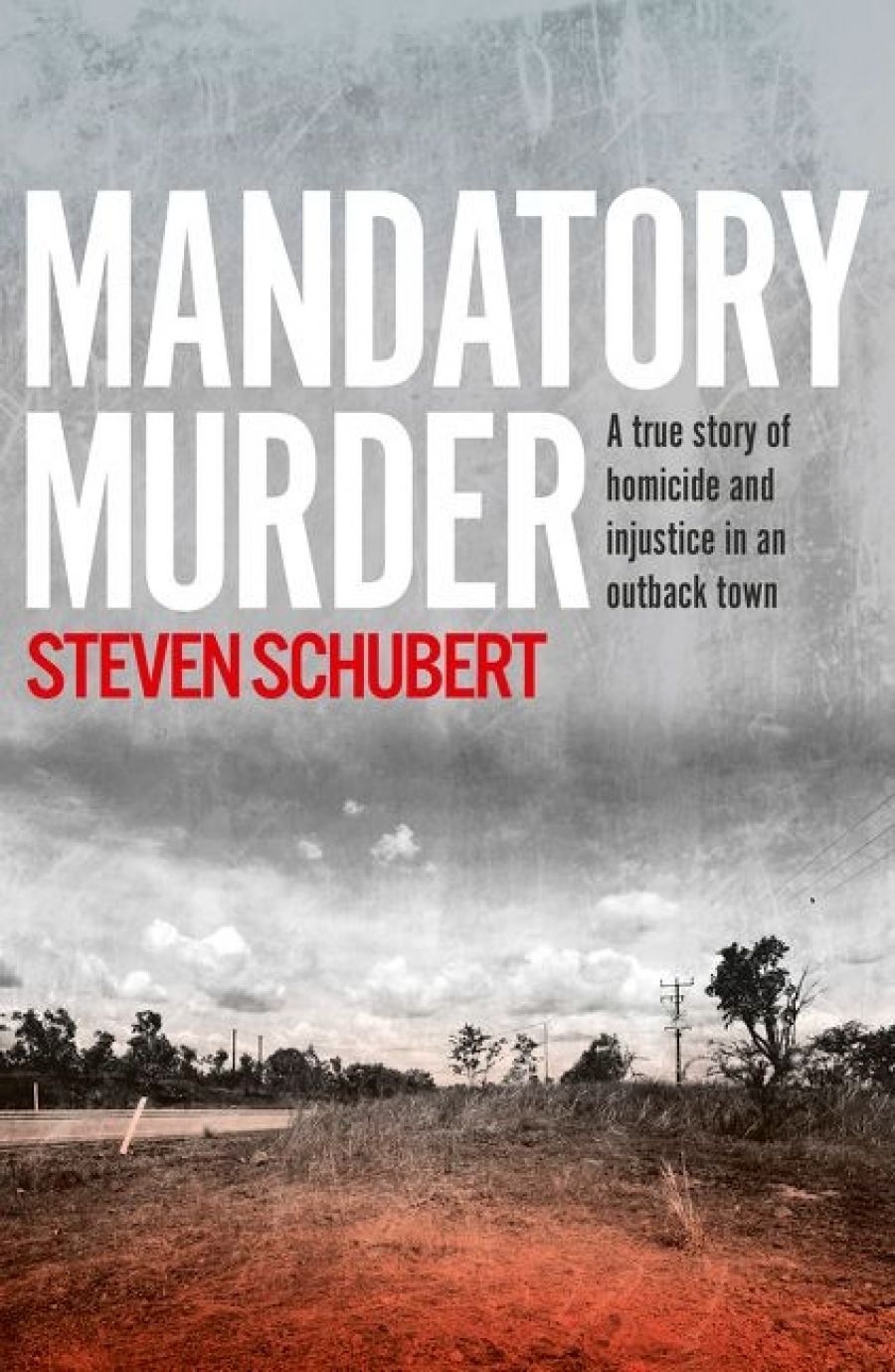
- Free Article: No
- Contents Category: True Crime
- Review Article: Yes
- Custom Highlight Text:
ABC journalist Steven Schubert’s first book, Mandatory Murder, could have been a definitive account of the bizarre sentencing of Zak Grieve for the murder of fellow Katherine resident Ray Niceforo in October 2011. To achieve this, it had to dig deeper and cover greater territory than existing accounts, including Dan Box’s mediocre documentary, The Queen & Zak Grieve, presented in six ‘webisodes’ on The Australian’s website.
Unfortunately, Mandatory Murder’s first 273 pages are given over to a fairly standard true-crime account – complete with shocksploitative details and police-style sardonic humour – of the investigation into Niceforo’s murder and the subsequent trials of Grieve, his mate Chris Malyschko, and Chris’s mother, Bronwyn Buttery (Niceforo’s partner). A third young man, Darren Halfpenny, separately pleaded guilty to murder. Although he doesn’t need to, Schubert seems to want to amplify the shock value; we even get gruesome colour photos supplied by police. True crime is a genre that often precludes illumination of the narratives of class and trauma that propel criminality in general, and this criminality in particular.
- Grid Image (300px * 250px):

- Book 1 Title: Mandatory Murder
- Book 1 Subtitle: A true history of homicide and injustice in an outback town
- Book 1 Biblio: ABC Books, $32.99 pb, 306 pp, 9780733339394
True crime is also a genre that, because it relies heavily on populist judgement of criminals, doesn’t lend itself easily to a story of injustice in which the convicted criminals are also victims, of a kind. But that’s the pivot Schubert attempts to make in the book’s concluding chapters, where he drops the sardonic tone and takes up an urgent plea for law reform. Schubert has Supreme Court Justice Dean Mildren explain the Northern Territory’s mandatory-sentencing laws. Malyschko, who killed Niceforo by repeatedly hitting him in the head with a spanner, could have his minimum twenty-year, non-parole period reduced, but Grieve could not, despite the Court’s finding that he wasn’t present at the time Niceforo was killed.
This sentencing disparity, widely seen as unjust, is the element that makes this particular murder more notorious than it might otherwise be. Readers are introduced to the policy idea behind it: a conviction for murder in the Norther Territory will see a person jailed for twenty years before he can apply for parole, unless he’s eligible for a discount for ‘exceptional circumstances’. A judge can only find exceptional circumstances in murder cases where the victim’s ‘conduct and condition’ ‘substantially mitigates’ the offender’s actions. Readers are introduced to Mildren’s reasoning: the judge could take into account Niceforo’s violence against Malyschko and his mother when sentencing Malyschko, but not when sentencing Grieve. Readers are introduced to the politics behind mandatory sentencing laws, with parliaments full of reactionary politicians attempting to exert control over the sentencing of offenders. Readers are introduced to some of the efforts to overturn these laws, and to the current conservative disposition of the High Court. We learn of Grieve’s application for mercy, which was ultimately successful.
All of this introducing is crammed within a mere thirty pages, at the end of the book. It’s possible to imagine a different book, one that selects these areas as the places to dig for details and narratives; that resists the temptation to exploit the trauma of a victim of domestic violence and the stupid brutality of a group of very young men; that looks more broadly and more incisively at the systems of race and class and poverty and policing governing the town of Katherine.
We don’t learn much about Grieve’s Aboriginality, or about the experience of being Aboriginal in Katherine. (His brother, Trevor, once worked for the North Australian Aboriginal Justice Agency in town.) We don’t learn much, though it’s implied, about the cultures of policing in the town and their responsiveness to allegations of domestic assault. All this is, of course, largely irrelevant to a ‘true crime’ account. But it’s central to the story of mandatory sentencing.
Schubert’s narrative style creates difficulties, because in labouring the details of the crime itself, readers are allowed to doubt the judge’s finding that Grieve was not present at the murder. Certainly, there is some evidence that he wasn’t there, but there is also evidence to the contrary. This uncertainty, while largely irrelevant to the law prohibiting murder, detracts from the moral force Grieve’s sentencing has for the prospects of law reform, which will be this terrible affair’s principal legacy for those unconnected with the participants.
I lived in Katherine for two years, as a lawyer, in the wake of Grieve’s sentencing. His social circle is one that doesn’t fit neatly into Schubert’s triumvirate typology of Katherine’s populations that ‘didn’t mix much’ (tradies and small-business owners; Aboriginal people; blow-in professionals). Grieve belongs to a stratum of Aboriginal families that live permanently in Katherine and that work to establish and maintain communication between the other groups, including Aboriginal people who come in from remote communities. I’d hoped for more explanation, more analysis, more reflection of the Katherine and the Northern Territory that I was briefly and bewilderingly a part of than Mandatory Murder provides. But true crime aficionodos will finish the book with a sense of the abominable injustice that mandatory sentencing perpetrates, especially on a dispossessed population that is excessively surveilled, arrested, and incarcerated.


Comments powered by CComment